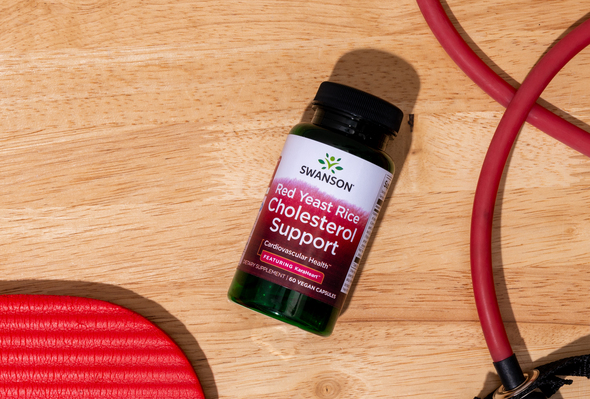What is Red Yeast Rice? Benefits and Uses
What is Red Yeast Rice? Benefits and Uses
Red yeast rice, sometimes referred to as Went yeast, has been used for centuries as part of traditional Chinese medicine.[1] It is produced by cultivating a specific type of yeast — a species of fungi called Monascus purpureus — on white rice.[2] This fermentation results in red yeast rice, which has been popular as both a food and a health supplement in Asia for decades. Recently, its popularity has surged in North America due to compelling research that demonstrates how the fermentation process produces beneficial compounds that may support heart health and general wellness.
Red Yeast Rice Benefits
During fermentation with Monascus purpureus, the fungi produce compounds known as monacolins, which are structurally similar to certain beneficial compounds. This discovery has spurred a growing body of research into how red yeast rice may provide a variety of potential health benefits.
Cardio & Cholesterol Support
In recent years, nearly half of all Americans have faced cardiovascular health issues.[3] Numerous studies suggest that red yeast rice can support healthy cholesterol and triglyceride levels in some individuals.[4] Additionally, other components in red yeast rice, such as phytosterols, unsaturated fatty acids, and isoflavones, may also contribute to its cholesterol-lowering effects.[5]
Overall Metabolic Health
According to the National Heart, Lung, and Blood Institute,[6] about one in three Americans have metabolic concerns, which are largely manageable.
Effective management includes maintaining a healthy weight, balancing blood sugar levels, supporting the immune system, and ensuring quality sleep. Some studies indicate that red yeast rice, combined with supplements like Berberine, can help maintain various health markers, supporting healthy weight management[8] and blood glucose control by promoting healthy insulin levels.[9]
Red Yeast Rice and Oxidative Stress
Medical professionals are increasingly concerned about oxidative stress — an imbalance between antioxidants and free radicals in the body that can cause cellular damage. Oxidative stress can also exacerbate joint health issues, respiratory problems, weight imbalances, and cognitive concerns.[10]
Red yeast rice contains numerous compounds that have been shown to help protect against oxidative stress.[11] For example, its plant-based sterols have been shown to positively influence markers of oxidative stress.[12]
The Potential Side Effects
Systematic analysis of over 50 clinical trials indicates that red yeast rice products and supplements are safe for some individuals.[13] However, people with pre-existing health conditions should be aware of potential side effects. It is important to consult a medical professional to understand how red yeast rice might interact with current medications, other vitamins, or supplements, or any existing health concerns.
Potential Weakened Immune System due to Citrinin
When seeking the best red yeast rice supplements, it is crucial to purchase from reputable sources that guarantee the potency and purity of their ingredients. Some low-quality red yeast rice supplements may contain citrinin,[14] a toxin that could weaken your immune system and damage your kidneys or cause symptoms of food poisoning.
Nausea and Muscle Damage
Red yeast rice may sometimes affect digestion, causing diarrhea, nausea, and stomach pain. Other possible, though rare, side effects include damage to the muscles, kidneys, or liver.[15]
Duration and Other Factors
If you have liver health concerns such as liver disease or consume alcoholic beverages daily, discuss the use of red yeast rice supplements with your doctor. You should avoid these supplements if you are pregnant, breastfeeding, or under the age of 20.[16] Due to limited research, consult your doctor before using red yeast rice supplements for more than 12 weeks and always discuss potential interactions with any medications you are taking, especially those for cholesterol and anticoagulants.
Who Should Take Red Yeast Rice?
Red yeast rice supplements may be considered for their numerous potential health benefits, but they are not suitable for everyone. Common reasons for taking red yeast rice include:
- Supporting healthy cholesterol levels and a healthy blood lipid profile
- Protecting against oxidative stress
- Maintaining balance in various health markers related to overall wellness and vitality
However, just because it is natural does not mean it is appropriate for everyone. Consult your doctor before using red yeast rice if you are:
- Pregnant
- Breastfeeding
- Currently taking prescription medications for any health concerns
- Experiencing kidney problems, liver disease, or muscle disorders
How Much Should I Take?
The appropriate dosage depends on various factors, such as your overall health status and the specific supplement you select. Beneficial results may occur with daily dosages ranging from 1,200 to 3,000 mg of red yeast rice. Always consult your healthcare providers for guidance and adhere to the manufacturer’s labeled guidelines on your chosen red yeast rice supplement.
Embrace Holistic Wellness with the Best Red Yeast Rice Supplements
Are you ready to explore the benefits of red yeast rice for your cholesterol, heart health, and overall health? Start with our collection of best-selling red yeast rice supplements.
You be well, now.
BubbForest
*These statements have not been evaluated by the Food and Drug Administration. These products are not intended to diagnose, treat, cure, or prevent any disease.
About Dr. Christopher Oseh
Christopher Oseh, MD, is a trained primary care physician with nearly a decade of clinical experience in managing and counseling patients toward better health through positive lifestyle changes. He has a strong record of treating and co-managing individuals with chronic illnesses.
Sources:
[1] Supplements for three common conditions. Harvard Medical School. Read source.
[2] Red yeast rice. Mayo Clinic. Read source.
[3] 2024 Heart Disease and Stroke Statistics Update Fact Sheet. American Heart Association. Read source.
[4] The effects of red yeast rice dietary supplement on blood pressure, lipid profile, and C-reactive protein in hypertension: A systematic review. Crit Rev Food Sci Nutr. Read source.
[5] Red yeast rice. Mount Sinai. Read source.
[6] National Heart, Lung and Blood Institute. What Is Metabolic Syndrome? Read source.
[7] Functional food red yeast rice (RYR) for metabolic syndrome amelioration: a review on pros and cons. World J Microbiol Biotechnol. Read source.
[8] Beneficial Effects of Red Yeast Rice on High-Fat Diet-Induced Obesity, Hyperlipidemia, and Fatty Liver in Mice. J Med Food. Read source.
[9] A nutraceutical combination improves insulin sensitivity in patients with metabolic syndrome. World J Cardiol. Read source.
[10] Chronic Inflammation. National Library of Medicine. Read source.
[11] A red yeast rice-olive extract supplement reduces biomarkers of oxidative stress, OxLDL and Lp-PLA2, in subjects with metabolic syndrome: a randomised, double-blind, placebo-controlled trial. Trials. Read source.
[12] Plant-based sterols and stanols in health & disease: “Consequences of human development in a plant-based environment?”. Progress in Lipid Research. Read source.
[13] Safety of red yeast rice supplementation: A systematic review and meta-analysis of randomized controlled trials. Pharmacol Res. Read source.
[14] Supplements for three common conditions. Harvard Medical School. Read source.
[15] Red Yeast Rice: What You Need To Know. National Center for Complementary and Integrative Health. Read source.
[16] Red yeast rice. Mount Sinai. Read source.





Leave a comment